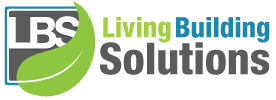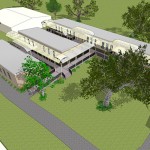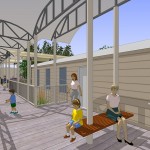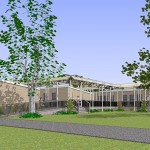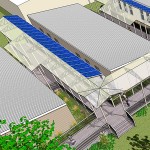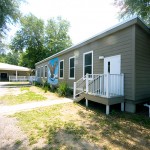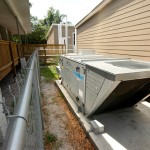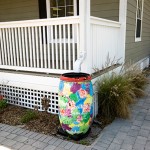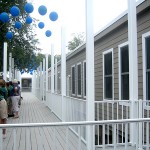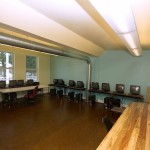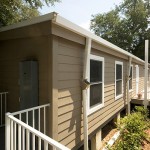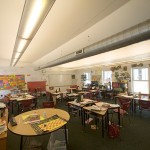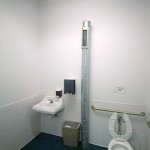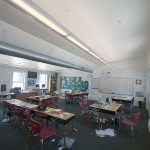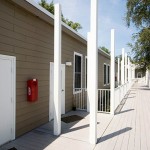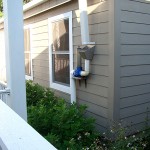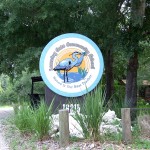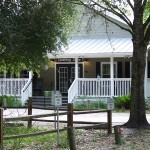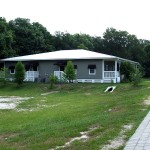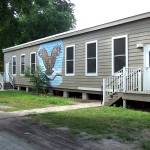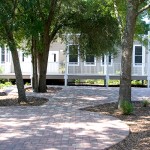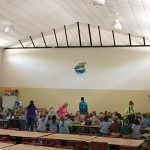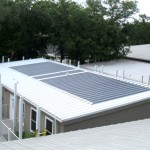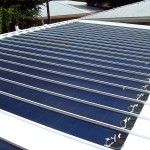Learning Gate Community School
Learning Gate Community School’s mission: To foster environmental stewardship through an innovative curriculum that pairs classroom lessons with hands-on learning experiences on the school’s unique and evolving 27-acre campus.
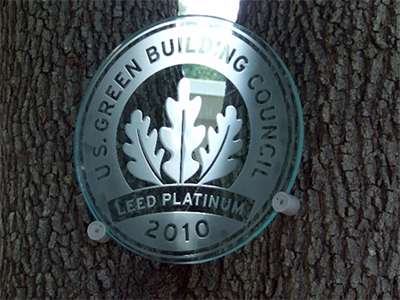 Learning Gate’s Awards
Learning Gate’s Awards
Learning Gate was named the 1st Public School in the Nation to achieve Platinum status through U.S. Green Building Council (USGBC) Leadership in Energy & Environmental Design (LEED) for Schools Program.
Learning Gate received the U.S. Department of Education Nomination to the Green Ribbon School Classification.
Learning Gate was honored with the Hillsborough County Planning Commission Environmental Excellence Award three times.
It is also a Project Learning Tree (PLT) Green School.
Learning Gate won the Florida Green School Award in 2011.
The unique curriculum has been in existence for 25 years and has been featured in Southern Living and Education Week.
Learning Gate Community School has also been awarded numerous recycling awards.
It also won the Rodale Institute School Garden award.
U.S. Green Building Council Report on Learning Gate Community School
The spirit of the school has always been feeling and teaching sustainability. It was only natural to continue their efforts of sustainability into this building. As part of its hands-on, nature-based curriculum, Learning Gate School has chosen to build all future additions to its campus in an environmentally friendly way. Learning Gate required additional classroom space for its growing student body and for this project, they chose to achieve LEED for Schools Platinum status. The students have become ambassadors for the project and have absorbed the principles within their daily routines. This LEED project encompasses three structures connected by a covered walkway with spaces including four restrooms and ten classrooms. One classroom was set aside for green and public education and will be available for use after hours and on weekends. This classroom highlights the technical and material features of the building. The recent “Green” and “No Child Left Inside” movements are not new to Learning Gate. Established in 1983 by Patti Girard as a “pre-school where kids get dirty,” we have been teaching students about taking care of the earth and loving it for 25 years. The successful pre-school grew to include a private elementary school and in August 2000, after applying for a charter, we opened our doors as the first environmentally-focused charter school in the state of Florida. Learning Gate is partially funded by the county and currently has 30 employees. Learning Gate has implemented walking trails, outdoor exercise/play areas, classroom gardens and outdoor swimming to stimulate the students’ appreciation of the outdoors. By utilizing natural daylight in different ways, the school has noticed an increase in student performance and productivity. Also, by creating a healthy atmosphere, teachers are more engaged and focused on learning. Less sick time and more learning takes place. The technology used to monitor the building energy use, volatile organic compounds (VOC) output, humidity levels and water consumption/reuse serve as teaching tools. The school chose the use of prefab structures similar to existing campus buildings. Issues such as indoor air quality, acoustics, and natural lighting were a paramount concern. To optimize energy performance, the owner wanted to minimize artificial lighting, install high-efficient fixtures, and utilize natural day-lighting. In considering the HVAC systems, the school wanted it as efficient as possible and was interested in pushing the envelope in this area. In specifying the equipment, first cost as well as long-term energy consumption was considered. Humidity control was incorporated to ensure occupant comfort. The HVAC systems were designed and tested to be properly sized for the project, reducing the energy consumption needed to cool the facility. Photovoltaic panels supply electricity for the facility. Water savings is a priority; a cistern was installed for rain and grey water harvesting, which can be used for irrigation and waste transportation. Low-flow fixtures were installed throughout for this project.
Because indoor environmental quality is so important to this project, CO2 is monitored to bring in additional fresh air as needed. To enhance the air quality, the use of UV technology was incorporated into the HVAC filter system design. Adhesives, sealants, paints and coatings, and carpet systems with low VOC content were used. All composite wood systems and agrifiber products were urea-formaldehyde free. For thermal comfort, the target dry bulb temperature is 75 degrees F with a relative humidity of 60%; the completed project far exceeds expectations. The use of soy-based spray foam insulation was chosen for its environmentally-friendly composition and superior performance levels.
Site context: Learning Gate is in more of a country setting similar to a farm. It gives the students a more country atmosphere for their learning environment similar to a summer camp, without the confines and of the traditional school setting. It adds to the Learning Gate philosophy of being sustainable and to use the surroundings in nature and building to educate the students about their environment. The 27-acre campus consists of one-floor buildings owned by the school. It is equipped with recycling and compost bins, rain barrels, and includes an organic garden, wetlands, gopher tortoise burrows, vermiculture colonies, a frog sanctuary and a bay grass nursery.
Drew Smith – LEED Project Administrator, Two Trails, Inc.
- Design innovation and cost and utility savings were two of the greatest motivators. The spirit of the existing school has always been the feeling and teaching of sustainability.
- A lot of our sustainable efforts went into indoor air quality. They are using a different type of air conditioning system, which is really not an air conditioning system. The indoor air quality is amazing. It really gives the students a great indoor learning environment. For us, this is probably the most successful part of the process.
- We used the Muenters air delivery system, a 100% ducted outside air conditioning unit. It is able to process the humidity of the entire space in reference to the outside air and keep consistent relative humidity level below 50%, even in the high humid climate in Florida, and is monitored on a minute-by-minute basis. This helped us achieve the mold protection credit (Indoor Environmental Quality credit 10).
- According to Mr. Smith, “I believe in building schools as modular projects. It allows for buildings to be built a lot more efficiently and quickly, in approximately half the time it takes to build it in a traditional sense, and it is a much more affordable cost.” So much of the shell of the building is being built in a manufacturing facility where so much of the waste can be minimized and saved. The manufacturing facility helps in driving the per-foot costs down from traditional brick and mortar buildings. When the buildings arrive on site, they become functional in a very short time period. Aesthetically pre-manufactured buildings have come a long way; they don’t look like manufactured buildings when they are completed. There is a little more to planning the process upfront, but once that process is complete, literally schools can be put up across the country at a very low cost, very effectively, and very resource-efficient, and have a healthy environment because so much of the process is controlled.
Charles Girard –General Contractor, Learning Gate Community School
The HVAC at Learning Gate is monitored by a BACnet Building Controller program, which enables real-time monitoring that monitors CO2, humidity, and temperature and is able to control all of those elements based on set points. The HVAC also has a filter system that uses UV light with MERV 13 and a precipitator screen. The UV creates a film on the precipitator screen; as the air passes through here, it’s washed of any lingering VOCs or any VOCs brought in by the teachers and students. For the acoustics, we used a soy foam insulation. Because there’s no base to measure soy in the modeling, we hired the University of Florida to do a physical test; they tested the transmission between rooms, into the bathrooms and media room, and from outdoor to indoor, and this is how we achieved the LEED acoustics point.
Link: Learning Gate Community School
The Educational Strategy at Learning Gate
For the past 13 years Learning Gate has been engaged in an aggressive strategy to conserve resources and eliminate waste.
(Note: The following programming was institutionalized by the founder and the innovative leadership of the school between its inception in 2000 and 2013, when all of these awards and recognition was earned. As a result of changes in leadership and strategy, some of these programs and curriculum are no longer in practice).
Water- developed an integrated water management plan that includes a 10,000 gallon rainwater harvesting system used to flush toilets, a rain barrel collection system for irrigation, an action project funded by PLT and implemented by 5th graders converting all faucets to hands-free and recently, a grant to construct a 200 gallon rainwater harvesting system for our organic garden. Results: 70% reduction in water usage; Future: a living machine/aquaponics system.
Waste– an initiative launched by kindergarteners resulted in a Waste Free Lunch Program, third grade students collect compostable foods and add to the garden compost pile and raise worms that generate compost and worm tea. Middle school students operate the electrical recycling program, fourth graders are responsible for ink cartridge recycling and the entire school recycles all paper, aluminum, glass, plastic, cardboard which is deposited into a single stream container. By developing a culture of reuse and repurposing, everyone brings reusable items for drink and food. We have a policy of accepting only compostable or recyclable containers from food vendors. Results: 75% reduction of waste sent to landfill; Future: paperless campus.
Energy– installation of a 5,120 watt solar system that resulted in a substantial reduction in energy use and GHG emissions, an ongoing energy conservation initiative that is led by middle school students who bring awareness to individuals about, turning off lights, conducting energy audits, efficient lighting, phantom electricity, thermostat regulating and developing alternative sources of energy. Results: 20% reduction in electric bill; Future: become net zero.
Health – Operational procedures and policies designed to support sustainability and provide a healthy environment, by purchasing green cleaning products, organic pest control, recycled paper, green office supplies, recycled equipment and furnishings, use of materials with no or low volatile organic compounds, including the adhesives, paints, insulation, flooring, and walls. All 800 students spend 30% of their day participating in outdoor classes; environmental, garden, physical education, low rope course and required free play time every day after lunch. Teachers use the outdoors as an extension of the classroom and a visit to our campus at any time will find students, reading, writing, measuring trees, testing water quality, building, singing, and dancing. Good eating habits are reinforced at the garden. Results: Happy, healthy kids; Future: build an Energy Star kitchen where students can plan and cook healthy lunches using our garden produce.
Education– Our Seed to Soup Curriculum ® is the heart of our teaching. It is designed to ensure that all our students attain an age appropriate level of environmental literacy. Literature selections have an environmental theme from which teachers plan and teach all subjects. An important aspect of our program is the development of over 150 lessons using our LEED Platinum Buildings as a teaching tool. Weekly environmental education classes actively engage students by having them manage the natural part of our campus, including inventorying trees/animals, removing invasive plants, planting native species to enrich the biodiversity on campus. Garden classes explore solar energy, water, growth patterns, soil cycles and every stage of our organic agriculture. Students are required to complete the Jr. Master Gardening program. Our middle school project based learning curriculum and Environmental Inquiry Classes provides students with hands on activities that demonstrate the sustainable features of green building, energy efficiency, water conservation, ecology restoration, and renewable energy and engages students in authentic, in-depth environmental projects, explores historical aspects of the nature of science, scientific investigation, and experimentation from a global perspective. Results: A+ High Performing Charter School; Future Plans: publish curriculum.
Outreach – Students, staff and parents are involved in community service projects, Adopt-A-Road and Pond, Bay Grasses restoration, Headstart programs, mitigation of wetlands, bird banding, donation of produce to the homeless shelter and organizing of Eco-Fest, and environmental education awareness for the surrounding community. Eco-Fest features exhibits, presentations and vendors that build community awareness, appreciation and advocacy for sustainable living. In 2011, Eco-Fest featured over 100 local businesses, farmers and artists with over 1,000 people in attendance. Results: awareness of Learning Gate as a resource for sustainability.
Reports
Learning Gate PR USGBC Indoor Laboratory Report Learning Gate Air Sampling Report Learning Gate Chemical Pollutants Report Learning Gate Board Endorsement C GirardFox 13 News Clip on Learning Gate’s Green Building Completion and Student Lessons:
Learning Gate School Curriculum:
“Nature is Our Best Teacher”
